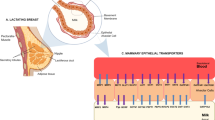Abstract
Human milk traicylglycerols (TAG) were analyzed by ammonia negative ion chemical ionization tandem mass spectrometry. The deprotonated molecular ions of triacylglycerols were fractionated at the first mass spectrometry (MS) stage. Twenty-nine of the deprotonated TAG ions were further analyzed based on their collisionally activated (CA) spectra. The tandem MS analysis covered eleven major acyl carbon number fractions, two of which contained odd carbon number fatty acids. Fatty acids of 28 different molecular weights were recorded from the daughter spectra. Hexadecanoic acid was present in all CA spectra, octadecenoic acid in the CA spectra of all mono- and higher unsaturated TAG, and octadecadienoic acid in the CA spectra of all di- and higher unsaturated TAG. The major fatty acid combinations in triacylglycerols were: with 0 double bonds (DB), 12∶0/12∶0/16∶0; with 1 DB, 12∶0/16∶0/18∶1; with 2 DB, 16∶0/18∶1/18∶1; with 3 DB, 16∶0/18∶2/18∶1; with 4 DB, 18∶2/18∶1/18∶1; and with 5 DB, 18∶2/18∶2/18∶1; hexadecanoic acid typically occupied thesn-2 position. The most abundant TAG was shown to besn-18∶1–16∶0–18∶1, comprising about 10% of all triacylglycerols.
Similar content being viewed by others
Abbreviations
- ACN:
-
acyl carbon number
- CA:
-
collisional activation
- DB:
-
double bonds
- FA:
-
fatty acid
- GC:
-
gas chromatography
- HPLC:
-
high-performance liquid chromatography
- MS:
-
mass spectrometry
- MS/MS:
-
tandem mass spectrometry
- MW:
-
molecular weight
- NICI MS:
-
negative ion chemical ionization mass spectrometry
- TAG:
-
triacylglycerols
References
Walstra, P., and Jenness, R. (1984)Dairy Chemistry and Physics, pp. 58–65, John Wiley and Sons, New York.
Freeman, C.P., Jack, E.L., and Smith, L.M. (1965)J. Dairy Sci. 48, 853–858.
Kuksis, A., Myher, J.J., and Marai, L. (1984)J. Am. Oil Chem. Soc. 61, 1582–1589.
Kuksis, A., Myher, J.J., and Marai, L. (1985)J. Am. Oil Chem. Soc. 62, 762–767.
Kuksis, A., Myher, J.J., and Marai, L. (1985)J. Am. Oil Chem. Soc. 62, 767–773.
Breckenridge, W.C., and Kuksis, A. (1967)J. Lipid Res. 8, 473–478.
Breckenridge, W.C., Marai, L., and Kuksis, A. (1969)Can. J. Biochem. 47, 761–769.
Kuksis, A., and Breckenridge, W.C. (1968) inDairy Lipids and Lipid Metabolism (Brink, M.F., and Krichevsky, D., eds.) pp. 28–98, AVI, Westport.
Weber, K., Schulte, E., and Thier, H.-P. (1988)Fat. Sci. Technol. 9, 341–344.
Lammi-Keefe, C.J., and Jensen, R.G. (1984)J. Pediatr. Gastroenterol. Nutr. 3, 172–198.
Davies, D.T., Holt, C., and Christie, W.W. (1983) inBiochemistry of Lactation (Mepham, T.B., ed.), pp. 71–117, Elsevier, New York.
Jensen, R.G. (1989)The Lipids of Human Milk, CRC Press, Inc., Boca Raton.
Watts, R., and Dils, R. (1968)Lipids 3, 471–476.
Tomii, S., Arachi, H., Ikeda, K., and Mega, T. (1977)J. Nara Med. Ass. 28, 734–739.
Yoon, T.-H., and Im, K.-J. (1985)J. Korean Soc. Food Nutr. 14, 39–46.
Kallio, H., and Currie, G. (1991) presented at the Short Course on HPLC of Lipids, Bloomingdale, May 9–11, p. 5, AOCS.
Kallio, H., and Currie, G. (1992)Lipids 27, 207–215.
Bligh, E.G., and Dyer, W.J. (1959)Can. J. Biochem. Physiol. 37, 911–917.
Kallio, H., and Currie, G. (1991) Australian Patent Application, No:PK4146, January 9.
Rey, J., Rey, F., and Schmitz, J. (1974)Biomedicine 2, 90–94.
Christie, W.W. (1988)J. Chromatogr. 454, 273–284.
Harzer, G., Haug, M., Dieterich, I., and Gentner, P.R. (1983)Am. J. Clin. Nutr. 37, 612–621.
Gibson, R.A., and Kneebone, G.M. (1984)Lipids 19, 469–471.
Christie, W.W., and Clapperton, J.L. (1982)J. Soc. Dairy Technol. 35, 22–24.
Weber, K., Schulte, E., and Thier, H.-P. (1989)Fat Sci. Technol. 3, 113–115.
Insull, Jr., W., Hirsch, T.J., James, T., and Ahrens, Jr., E.H. (1959)J. Clin. Invest. 38, 443–450.
Author information
Authors and Affiliations
About this article
Cite this article
Currie, G.J., Kallio, H. Triacylglycerols of human milk: Rapid analysis by ammonia negative ion tandem mass spectrometry. Lipids 28, 217–222 (1993). https://doi.org/10.1007/BF02536642
Received:
Revised:
Accepted:
Issue Date:
DOI: https://doi.org/10.1007/BF02536642




